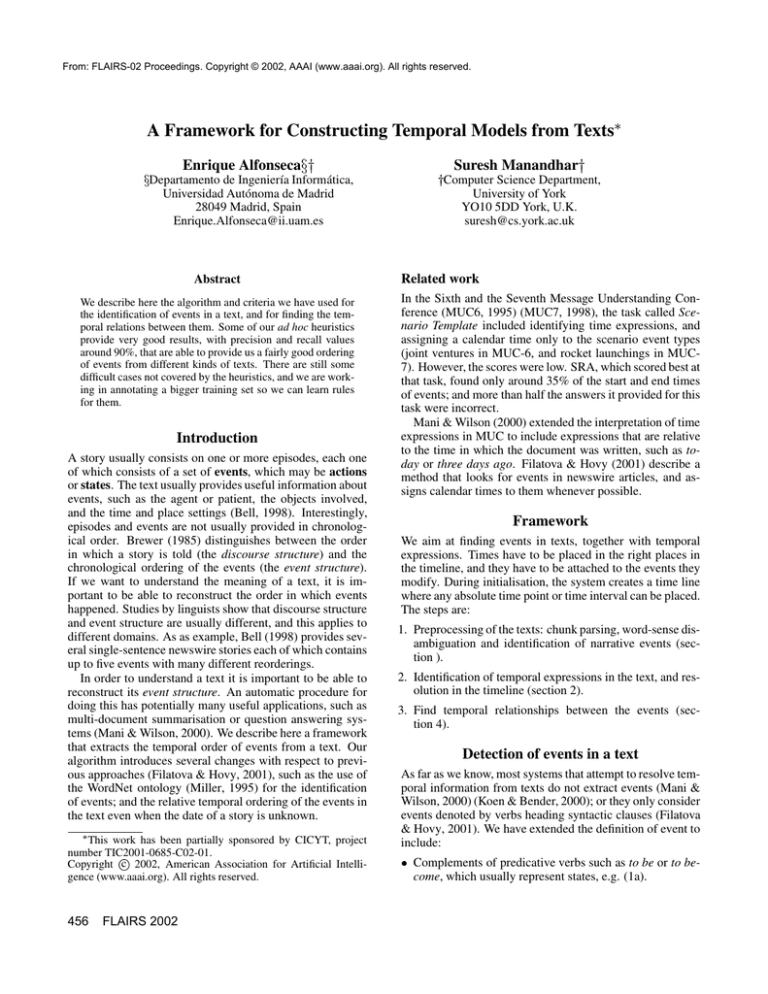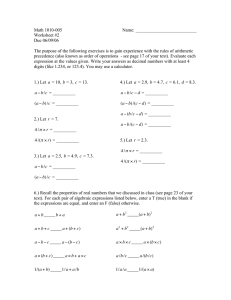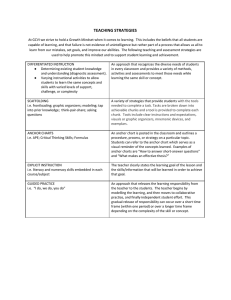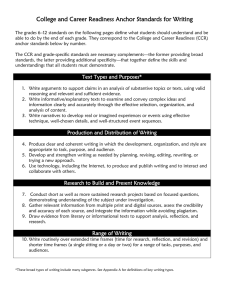
From: FLAIRS-02 Proceedings. Copyright © 2002, AAAI (www.aaai.org). All rights reserved.
A Framework for Constructing Temporal Models from Texts
Enrique Alfonseca
Departamento de Ingenierı́a Informática,
Universidad Autónoma de Madrid
28049 Madrid, Spain
Enrique.Alfonseca@ii.uam.es
Abstract
We describe here the algorithm and criteria we have used for
the identification of events in a text, and for finding the temporal relations between them. Some of our ad hoc heuristics
provide very good results, with precision and recall values
around 90%, that are able to provide us a fairly good ordering
of events from different kinds of texts. There are still some
difficult cases not covered by the heuristics, and we are working in annotating a bigger training set so we can learn rules
for them.
Introduction
A story usually consists on one or more episodes, each one
of which consists of a set of events, which may be actions
or states. The text usually provides useful information about
events, such as the agent or patient, the objects involved,
and the time and place settings (Bell, 1998). Interestingly,
episodes and events are not usually provided in chronological order. Brewer (1985) distinguishes between the order
in which a story is told (the discourse structure) and the
chronological ordering of the events (the event structure).
If we want to understand the meaning of a text, it is important to be able to reconstruct the order in which events
happened. Studies by linguists show that discourse structure
and event structure are usually different, and this applies to
different domains. As as example, Bell (1998) provides several single-sentence newswire stories each of which contains
up to five events with many different reorderings.
In order to understand a text it is important to be able to
reconstruct its event structure. An automatic procedure for
doing this has potentially many useful applications, such as
multi-document summarisation or question answering systems (Mani & Wilson, 2000). We describe here a framework
that extracts the temporal order of events from a text. Our
algorithm introduces several changes with respect to previous approaches (Filatova & Hovy, 2001), such as the use of
the WordNet ontology (Miller, 1995) for the identification
of events; and the relative temporal ordering of the events in
the text even when the date of a story is unknown.
This work has been partially sponsored by CICYT, project
number TIC2001-0685-C02-01.
Copyright c 2002, American Association for Artificial Intelligence (www.aaai.org). All rights reserved.
456
FLAIRS 2002
Suresh Manandhar
Computer Science Department,
University of York
YO10 5DD York, U.K.
suresh@cs.york.ac.uk
Related work
In the Sixth and the Seventh Message Understanding Conference (MUC6, 1995) (MUC7, 1998), the task called Scenario Template included identifying time expressions, and
assigning a calendar time only to the scenario event types
(joint ventures in MUC-6, and rocket launchings in MUC7). However, the scores were low. SRA, which scored best at
that task, found only around 35% of the start and end times
of events; and more than half the answers it provided for this
task were incorrect.
Mani & Wilson (2000) extended the interpretation of time
expressions in MUC to include expressions that are relative
to the time in which the document was written, such as today or three days ago. Filatova & Hovy (2001) describe a
method that looks for events in newswire articles, and assigns calendar times to them whenever possible.
Framework
We aim at finding events in texts, together with temporal
expressions. Times have to be placed in the right places in
the timeline, and they have to be attached to the events they
modify. During initialisation, the system creates a time line
where any absolute time point or time interval can be placed.
The steps are:
1. Preprocessing of the texts: chunk parsing, word-sense disambiguation and identification of narrative events (section ).
2. Identification of temporal expressions in the text, and resolution in the timeline (section 2).
3. Find temporal relationships between the events (section 4).
Detection of events in a text
As far as we know, most systems that attempt to resolve temporal information from texts do not extract events (Mani &
Wilson, 2000) (Koen & Bender, 2000); or they only consider
events denoted by verbs heading syntactic clauses (Filatova
& Hovy, 2001). We have extended the definition of event to
include:
Complements of predicative verbs such as to be or to become, which usually represent states, e.g. (1a).
Corpus
MUC-3
LOTR
WSJ
IBM
Total
Events (human)
66
67
73
78
284
Events (system)
65
66
77
73
281
Correct
59
59
67
68
253
Recall
89.39%
88.06%
91.78%
87.17%
89.08%
Precision
90.77%
89.39%
87.01%
93.15%
90.03%
Table 1: Results (precision and recall) for the identification of events in the sample texts.
Verbs with lexical information, i.e. excluding auxiliary,
modal and predicative verbs; these verbs represent actions
or states, e.g. (1b).
Nouns that, in the WordNet taxonomy, are hyponyms
(specifications) of one of the three concepts act , e.g.
arrival in (1c); event , e.g. accident in (1c); or
state , e.g. danger in (1d).
(1) a. He was strong at the time.
b. The train arrived on time.
c. The accident was known before his arrival.
d. The general was in danger.
Because some nouns may have some senses that represent events and some that don’t, it is necessary to use a word
sense disambiguation procedure that decides with which
sense a noun is used in a given context. In our preliminary experiments we have simply used a baseline procedure
that assigns, to every noun, the sense with which it is more
frequent in the S EMCOR sense-tagged corpus (Landes, Leacock, & Tengi, 1998), but accuracy could be increased with
a better algorithm.
Results detecting events
We have applied those criteria to four small texts from different domains: one newswire article from the MUC-3 training data, about terrorism; the first sentences from the Wall
Street Journal (WSJ) corpus; and sentences from a corpus with IBM program instructions, all of them obtained
from the Penn Treebank version II (Marcus, Santorini, &
Marcinkiewicz, 1993); and the first sentences from the first
chapter of The Lord of the Rings (LOTR) (Tolkien, 1968).
These texts were processed using the TnT part-of-speech
tagger (Brants, 2000) and our own cascade of chunk parsers
based on transformation lists (see (Ramshaw & Marcus,
1995)). The resulting events were compared to the annotation produced by a human.
The metrics used are for measuring its accuracy are recall, the fraction of correct events that were found in the test
corpus; and precision, the fraction of the events proposed
by the system that were correct.
The overall results detecting events in the text are shown
in Table 1. As a comparison, we can cite that Filatova &
Hovy (2001) obtained a recall of 60.76% and a precision of
55.81%. However, we are not using the same corpora and
we do not know which were their annotation guidelines, so
we do not think that our respective results are comparable.
The program attains similar results in the first three documents, most of the errors being due to part-of-speech tagging
and parser mistakes. The recall of the IBM manual is lower
because most of the verbs in the section titles appeared capitalised, and the part-of-speech tagger mistagged them all as
proper nouns.
Finding information about events
Our chunk parser, when possible, extracts subject-verb and
verb-object relationships from the texts. With this information, we could find the agents of roughly one third of the total
events identified in the texts. To find the agent of a nominal
event we also looked at genitive constructions, such as that
in sentence (2).
(2) I waited for Peter’s arrival
Anchoring events in time
When a writer narrates a story, the events that he or she is
telling can be classified in three groups: past events, present
events and future events. Every event in the first group will
be told in past tense, every current event will be told in
present tense, and every future event will be told in future
tense. Occasionally, some verbal times can be used in other
forms, such as those in sentences (3a) and (3b). Usually,
when this phenomenon happens, there are explicit time expressions (e.g. in 1492 and tomorrow) that show that the
tense of the verb is not being used in the usual way.
(3) a. After many days navigating, Colon finally discovers
America in 1492.
b. Tomorrow I go to see my parents.
This can be further complicated by the fact that we can
embed narrations inside narrations, for instance, when a person in a novel speaks. In that case, the verb tenses in the
person’s utterances are relative to the time at which that person speaks. We have called anchor time the time at which
the narration happens, and anchor rules the criteria used
for finding temporal relationships from a verb and the anchor time using its tense. If, while processing a text, we find
an event of speaking that introduces a new narrative context,
we use the time of that event as the new anchor time for that
context.
The anchor rules are necessary because, when the embedded narration is not quoted literally, but stated as a subordinate clause introduced by the complementiser that, then
present tenses and future tenses are transformed into past
and conditional tenses, so we can recognise which verb
tenses refer to the time when the utterance was produced
and which refer to now. Table 2 shows when the event of
going is interpreted to happen for each of the sentences in
(4).
FLAIRS 2002
457
Sentence
(4a)
(4b)
(4c)
(4d)
(4e)
go happens after...
the event of saying
the event of telling
the event of saying
now
the event of saying
Table 2: Temporal relation between going and other events
in the example sentences in (4).
(4) a.
b.
c.
d.
e.
Peter told me yesterday, ‘John said that he would go’.
Peter told me yesterday, ‘John said that he will go’.
Peter told me yesterday that John said ‘I will go’.
Peter told me yesterday that John said that he will go.
Peter told me yesterday that John said that he would
go.
The algorithm is displayed in Figure 1. Initially, the document has to be placed in the timeline, at the initial anchor
point. If the document contains a header specifying its date,
then we can place it at a fixed point in the timeline; otherwise, we just assign to it an unknown time point. Every
event that is described in past-tense will be placed before
the document’s time. And, inversely, future-tense verbs will
describe events that happen after the writing of the document. The anchor time will also help in locating in time
expressions such as today or three months ago.
Next, time expressions are identified in the document, and
the events they modify are placed accordingly in the time
line. After that, prepositions and conjunctions introducing
event clauses are used to find the ordering of the remaining events. Finally, if there is any event of narrating, it is
processed, but the anchor point for the events inside the narration will be the time when the narration occurred.
Identifying time expressions
Writers place events in time using Time-denoting expressions (Móia, 2001), such as three days ago. These expressions refer to intervals in time. We have compiled a list
of regular expressions in a FLEX file to recognise absolute
(e.g. dates) and relative (e.g. today) time stamps. This expressions can be easily used to place the events modified by
them in the timeline. In our experiments, a total of 22 expressions were found, giving a total recall of 87.5%, and a
precision of 95.45%.
After time-denoting expressions have been found, we use
prepositions and conjunctions to translate them into absolute
or relative time-intervals. Some time expressions, such as
today or tomorrow, or time prepositions such as ago are relative to the anchor time; while other time expressions such
as before or after are relative to the time of the event in the
main clause. All this is taken into account.
In our sample texts, the simple heuristic of assigning the
time to the nearest event in the same syntactic clause was
100% correct, for the 21 expressions found in the text.
Finally, Table 3 displays the number of temporal relationships that were discovered using the anchor rules. The first
column shows the total number of relationships discovered,
458
FLAIRS 2002
Corpus
MUC-3
LOTR
WSJ
IBM
Found
61
51
95
32
Expanded
911
183
1226
1083
Table 3: Results for finding temporal relations between
events, using the verb tenses and the temporal expressions.
and the second column shows the number inferences from
the previous, by applying the symmetry of the simultaneous relationship and the transitivity of the preceding relationship:
In the LOTR corpus there were few inferences, because most
of the verbs were in past tense (preceding the anchor time)
and there were few temporal expressions with which place
the events in the timeline.
Reordering the events
Consecutive sentences often convey chronological events.
When that is not the case, prepositions and conjunctions provide the information to correctly interpret the sentences. The
following are several examples of ways to express temporal relationships, such as preceding events, in (5a); consecutive events, in (5b); simultaneous, in (5c); subevent relationships, in (5d); or overlapping events, as in (5e).
(5) a. Unfortunately, I left before your arrival.
b. Several witnesses cried after the accident.
c. While I was waiting for you, I read the whole magazine.
d. While he was driving home, he passed a red light.
e. While I was parking my car, it started raining.
Although the temporal relationships found already provide us with a good overview of the order of the events in
the texts, we can still find many events whose position in the
timeline is not known, but we think that temporal prepositions and conjunctions, together with semantic information
from the verbs could be useful to find it. However, preliminary experiments using a Maximum Entropy model to find
these remaining relations suggest that our training set is too
small to hold a representative number of the many ways that
language provides to express temporal events, so we probably need to annotate a bigger amount of data or use an ad
hoc solution.
Conclusions and Future Work
We describe here a procedure for identifying and resolving
time expressions in texts, and for reconstructing the chronological ordering of events from a text. Our algorithms seem
to be general enough to be used with documents from different domains, such as political news, financial news, novels
and user manuals.
The method we have built for identifying events has two
advantages over previous approaches: WordNet is used to
Process(document)
1. Assign the document’s date to a point in the timeline (the anchor time).
2. anchor rules
relations between each verb tense and the anchor time.
2. Find tenses(anchor time, anchor rules, document)
Find tenses(anchor time, anchor rules, document)
1. Find temporal expressions in the text.
2. Use these temporal expressions to place a few events in time.
2.1. If they are absolute expressions, place the events in the timeline.
2.2. If they are relative to the anchor time, place them accordingly.
3. Use the anchor rules to find relations between the verbal events and the anchor time.
4. Find temporal relations between events, using features such as prepositions (before, after, etc.).
5. For every narration event,
5.1. fragment portion of the document with the narration.
5.2. new anchor time the time when the narration event takes place.
5.3. Create the new anchor rules for the fragment:
5.4. If the narration is a literal citation, tenses are relative to new anchor time.
5.5. Else,
5.5.1. Past and conditional tenses are relative to new anchor time, as present and future.
5.5.2. Present and future tenses refer to the current anchor time.
5.6. Find tenses(new anchor time, new anchor rules, fragment)
Figure 1: Pseudocode of the algorithm for finding temporal relations between events.
identify common nouns that can represent events, and we
allow different events to be in the same clause, even if they
happened at different times. Therefore, we do not need a
robust parser for our experiments.
Next, we describe a new algorithm for resolving the time
expressions, regardless of whether they are absolute calendar dates, relative to the time when the text was written, or
relative to the event in the main clause. The advantage of our
algorithm is that it deals easily with embedded narrations, by
updating a set of anchor rules that keep track of the semantic meaning of verb tenses in each case. This is specially
useful for processing newswire articles and novels, because
both include speeches quite often.
Finally, the extension of the events with information about
the agents and objects of the action events is useful for answering questions such as (6).
(6) a. How many times did Frodo visit Lorien?
b. How often has the current president of Portugal travelled abroad?
The following are a few open lines and improvements that
we may be addressing in the future:
Detecting event’s coreference, so two references to the
same event are merged in one.
Improve modules such as the word-sense disambiguator
or the parser.
Consider people’s ages as time expressions.
Because many of the systems to find temporal expressions
in the MUC conferences attained high results using regular expressions, we have tried the same approach, with very
good results. However, some of these expressions have still
to be disambiguated. Mani & Wilson (2000) used a decision
tree classifier for distinguishing senses such as the two of the
word today: the general (similar to nowadays) and the spe-
cific one. The same approach could be followed to decide
whether a present-tense verb refers to a universal truth or to
an event happening right now.
References
Bell, A. 1998. The Discourse Structure of News Stories.
Allan Bell and Peter Garret, eds., Blackwell Publishers.
chapter 3, 64–104.
Brants, T. 2000. TnT - A Statistical Part-of-Speech Tagger.
User manual.
Brewer, W. F. 1985. The story schema: universal and
culture-specific properties. Cambridge University Press.
167–94.
Filatova, E., and Hovy, E. 2001. Assigning time-stamps
to event-clauses. In Workshop on Temporal and Spatial
Information Processing, ACL-2001.
Koen, D. B., and Bender, W. 2000. Time frames: Temporal
augmentation of the news. IBM Systems Journal 39(3/4).
Landes, S.; Leacock, C.; and Tengi, R. 1998. Building
Semantic Concordances. In (C. Fellbaum (Ed.) WordNet:
An Electronic Lexical Database. MIT Press.
Mani, I., and Wilson, G. 2000. Robust tempral processing
of news. In 38th Anual Meeting of the ACL (ACL’2000).
Marcus, M. P.; Santorini, B.; and Marcinkiewicz, M. A.
1993. Building a large annotated corpus of english: the
penn treebank. Computational Linguistics 19(2):313–
330.
Miller, G. A. 1995. WordNet: A lexical database for English. Communications of the ACM 38(11):39–41.
FLAIRS 2002
459
Móia, T. 2001. Telling apart temporal locating adverbials
and time-denoting expressions. In Workshop on Temporal
and Spatial Information Processing, ACL-2001.
MUC6. 1995. Proceedings of the 6 Message Understanding Conference (MUC-6). Morgan Kaufman.
MUC7. 1998. Proceedings of the 7 Message Understanding Conference (MUC-7). Morgan Kaufman.
Ramshaw, L. A., and Marcus, M. P. 1995. Text chunking
using transformation-based learning. In Third ACL Workshop on Very Large Corpora, 82–94. Kluwer.
Tolkien, J. R. R. 1968. The Lord of the Rings. Allen and
Unwin.
460
FLAIRS 2002






